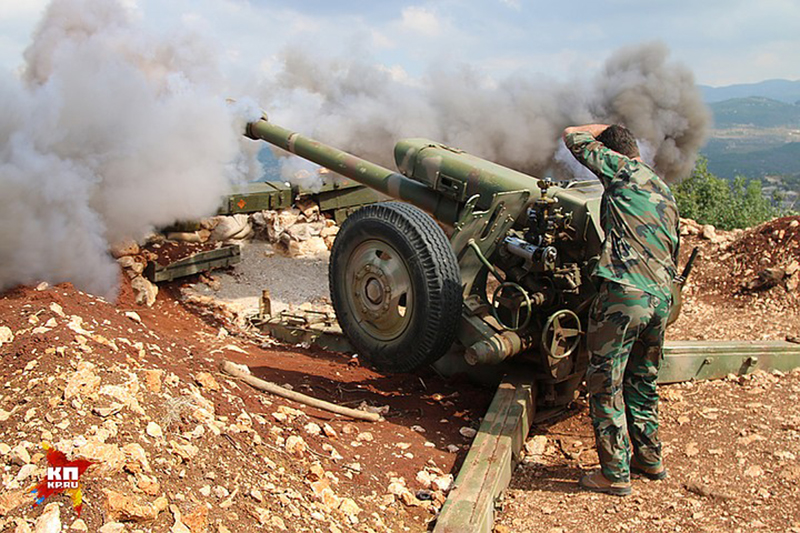
Original by Aleksandr Kots and Dmitriy Steshin published by Komsomolskaya Pravda; translation by J.Hawk
With whom and against whom?
One of the key parts of Vladimir Putin’s special address contained the following: “As far as ISIS, Jabhat al-Nusra, and other terrorist organizations which were identified as such by the UN Security Council are concerned, they are fully excluded from the ceasefire. Attacks against them will continue as before.” If ISIS and Al-Nusra are more or less clear, it’s still not known which “other terrorist organizations” are black-listed by the UNSC. Therefore the interested parties are continuing heated debates on that issue behind closed doors. It’s obvious that the final list of terrorist groups will be the product of an agreement between Russia and US. But that list is still not available to the public. Perhaps it does not even exist yet as such.
It is expected that by February 27, that list ought to appear thanks to the coordinating center that was established at the Hmeimim airbase. That’s where groups which desire to join the ceasefire will be registered. There are about 200 of them all over Syria. Some armed opposition units already announced they reject ceasefire conditions. Which means that, like some time ago on the Donbass, the ensuing peace will amount to a noisy mirage. In Syria, there are also plenty of uncontrolled “territorial battalions” and “volunteer detachments” which can endanger the fragile peace.
One ultimately has to keep in mind that we are in a card game with hard-core card sharps. Even the “secular opposition” which loves to demonstrate its “constructiveness” and “negotiations suitability” can use the pause to regroup and rearm. Analogies to Ukraine’s south-east suggest themselves. The result of Minsk-2 which was never implemented by Kiev was felt very painfully by the inhabitants of Donetsk, Gorlovka, and Yasinovataya during the last few days.

Even when attacking legal targets, it will be difficult to avoid a conflict of interests. The Saudis will never agree with designating such formations as Jaysh al-Islam and Ahrar ash-Sham as terrorist. Turkey is unlikely to stop shelling Kurdish areas in northern Aleppo. Erdogan hastened to confirm that supposition in his announcement: “The Kurds must be excluded from the ceasefire agreement, they will continue to be targeted.”
Yugoslavia’s ashes in the heart of Syria?
So how will the geography of war change if we take into consideration only the al-Nusra and ISIS, which nobody wants to defend?
The first is present in nearly every province of Syria–Aleppo, Idlib, Hama, Damascus, Deraa, Kuneitra. In some sectors of the front al-Nusra happily coexists with Free Syrian Army, which renders the FSA into a legal target for the Russian aircraft. In recent days during the battles on the Aleppo “road of life”, al-Nusra even entered into a coalition with ISIS by cutting the only supply route on the desert road through Hanasser.
ISIS has not been noted as a friend of the FSA before. The geography of war against ISIS will remain as before–the army will continue its offensive against the terrorists’ main concentration in Raqqa province, against the khalifate positions in Deir ez-Zor, and will become more active in the area of Palmyra.

Accepting the ceasefire terms, Damascus gets the ability to release assets from the temporarily “pacified” territories and throw them into an offensive against the Islamists. This naturally create the danger of an attack against the weakened flanks. After all, the only guarantee that the moderate opposition will remain quiet is the US. And here the US is not viewed as very trustworthy. Especially since John Kerry immediately after the ceasefire was negotiated suddenly mentioned some “plan B” which, as some in Damascus fear, may entail a forcible partition of Syria into several parts.
The ideal outcome of the ceasefire would be the country’s federalization. It is, unfortunately, unavoidable. Even at the start of the Syrian schism, analysts said that the Syrian Arab Republic will no longer exist within 2010 borders. The ring has four corners, and it seems that every participant of this mass brawl will have his own spot. The West has experience in creating ultra-complex state entities which, to everyone’s amazement, turn out to be stable and exist for decades.
Incidentally, all complex systems are stable and are self-regulating. We have an example of one in the form of Bosnia-Herzegovina, a state born of the Dayton Agreements of 1995 and which has the most complex federal system in the world. Its currency is the “convertible mark” pegged to the Euro. Populated by Muslims, Catholics, and Orthodox Christians.
Joint combat operations against these irredeemable psychopaths would be preferable to any “protocols of intentions.” Or at least a hard and honest neutrality. There are many examples in history, such as Finland’s exit from World War 2. Italy’s “correction of errors” after overthrowing Mussoline. Or the wholly neutral and even subversive Turkish participation in Hitler’s Axis and the anti-Nazi coalition which allowed it to avoid being part of the “final judgment” of 1945.






Those rebel groups that reject the ceasefire should be tagged as “terrorists” and bombed into extinction.
Then who is a “terrorist” and who is not will be very clear cut.
It is not for the Saudis or Turks to tell the world the difference.